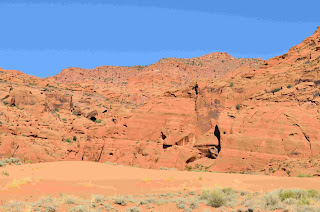Hurricane Utah 7/7/2013-7/12/2013 That is pronounced “Her-ah-kun” by the locals.
On arrival we got a taste of why
this town is called Hurricane with a thunder storm accompanied by very strong
sudden winds and hail. Wow, what a
surprise. Later I looked on the internet and found that Hurricane was first settled in 1896, and received its name after a whirlwind blew the top off of a buggy that Erastus Snow was riding in. Snow exclaimed, "Well, that was a Hurricane. We'll name this 'Hurricane Hill'." Nothing like a good chuckle for the day.
Weather has mostly been really hot
(115-116) but mornings have been ok so we have done most of our bike riding and sightseeing
in the early mornings.
Snow Canyon State Park:
Snow Canyon is not named for snow
but rather the canyon was named after early settlers Lorenzo
and Erastus Snow
that came upon the canyon while looking for their lost cattle in the 50’s. It was designated as a Utah State Park in
1958. Snow Canyon State Park is located
amid ancient lava flows and beautiful sandstone cliffs. This beautiful canyon features red rock
formations, sand dunes and ancient lava flows from an extinct Volcano (more
than 27,000 years ago). We did some early
morning bike rides along the Whiptail Trail where we experienced majestic views
filled with a unique interplay of light and dark and color across the canyon
walls.
 |
Snow Canyon Panoramic View
Snow Canyon Sand Dunes
Snow Canyon Ancient Lava Flows
Zion National Park:
The drive up to Zion National Park
was picturesque. Once in the park, we
began with a short bike ride on the Pa'rus Trail which rides along the Virgin
River, up the wide valley of the southern Zion Canyon. Throughout the ride we were surrounded by
grand towers cast in brilliant oranges, browns, and reds.
|
Zion Pa’Rus Trail
After riding the Pa'rus
Trail we returned to our starting point and took the shuttle from the Zion Visitor’s
Center. The road into Zion Canyon is
just 6 miles, ending at the Temple of Sinawava , referring to the Coyote God of
the Paiute Indians. Next trip to Zion we will take the bikes on the
shuttle and do the ride back, which is mostly downhill. We walked the 2 mile
roundtrip River Walk to the Temple where the canyon narrows and a foot-trail
continues to the mouth of the Zion Narrows. For the adventurous, this is where the famous
Narrows hike begins (listed in National Geographic as ‘America’s 100 Best
Adventures’). This hike almost isn’t a hike as it involves
around ½ of the 8-12 hour adventure wading through the Virgin River (as opposed to hiking).
The river is cold and wetsuits are recommended.....not this trip.
|
Zion River Walk Trail
|
A Local Squirrel
While in the park we decided to ride through the Mt. Carmel Tunnel, a very impressive 1.1 mile engineering feat of the late 1920's. Vehicles over 13ft. 1 inch tall are not permitted.
|
Mt. Carmel Tunnel entrance
|
No worries, only our GPS didn't get the
message that the 5th wheel
was left back at the campground
|
Inside the tunnel-1.1 miles of narrow darkness
|
Leaving Zion, amongst more varied colors, after a wonderful afternoon
Our last day was spent kicking around the old town of Hurricane. We visited the original canal and learned how settlers as early as 1867 realized they had very fertile farmland, but were in serious need of water. We learned how the construction of the Hurricane Canal is a Utah story of pioneer determination. This canal was built completely by hand, 7.5 miles long, with numerous tunnels taking 11 years to complete. Once completed in 1904, however, the canal brought water to 2000 acres of prime farmland and made it possible for early settlers to build futures in Hurricane, Utah.
We also visited Lookout Point. Prior to construction of the canal, the few families in the area survived by grazing cattle. To protect their livestock from wild animals and Indians, the cattle were held overnight in a rock corral (known as Rock Fort). They had a guard at night and wood and brush were stored nearby so it could be ignited in the event of trouble. Upon seeing the signal of smoke and flames, armed horsemen would charge out to defend. Only once was the wood and brush ignited, bringing the town's men in a hurry on horseback. This one time ignition was caused by a mischievous 'youngster', Tommy Willis. Bob and I laughed about how kid's don't change over generations and also how this kid's actions resulted in his name being documented in the history journals of this town.
Heading back to our campsite we stumbled upon the local correctional facility....really....who names a correctional facility Purgatory? Took a picture and the name created enough curiosity to research. We were surprised to discover not only that it is located close to Purgatory Flats (thus the name) but that it is also where Warren Jeffs was housed for 12 months and was later tried and convicted in a local area court.

We leave in the morning. Next stop......Green River, Utah.
|











No comments:
Post a Comment